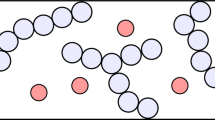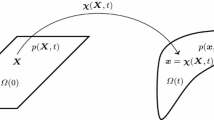Abstract
In this work, a simple solution strategy for the fully coupled problem of the diffusion of a mobile constituent into an elastic solid is proposed. The key features of the proposed solution strategy are a superconvergent strain recovery and a final stress filtering, suitably arranged with a standard recursive staggering scheme. The strategy is devised to overcome some shortcomings arising when solving the problem within the standard finite element framework and can be easily implemented by using existing finite element packages for uncoupled elasticity and diffusion problems. Numerical applications show the effectiveness of the proposed solution strategy.
Similar content being viewed by others
References
Zakroczymski T, Glowacka A, Swiatnicki W (2005) Effect of the hydrogen concentration on the embrittlement of a duplex stainless steel. Corros Sci 47: 1403–1414
Wang M, Akiyama E, Tsuzaki K (2005) Effect of hydrogen and stress concentration on the notch tensile strength of AISI 4135 steel. Mater Sci Eng Part A 398: 37–46
Toribio J, Kharin V (2000) A hydrogen diffusion model for applications in fusion nuclear technology. Fusion Eng Des 51–52, 213–218
Woodtli J, Kieselbach R (2000) Damage due to hydrogen embrittlement and stress corrosion cracking. Eng Fail Anal 7: 427–450
Ryumshina TA, Illyashenko SP (1999) Study of stress and strain fields in an infinite plate exposed to hydrogen diffusion. Int J Hydrogen Energy 24: 825–828
ASM Handbook, vol. 5. ASM International, Materials Park (1996)
Marras SI, Ihatiaris IA, Hatzitrifon NK, Sikalidis K, Ainfantis EC (2000) A preliminary study of stress-assisted fluid penetration in ceramic bricks. J Eur Ceram Soc 20: 489–495
Shanati S, Ellis NS, Randall TJ (1995) Coupled diffusion and stress by the finite element method. Appl Math Model 19: 87–94
Thomas JP, Chopin CE (1999) Modeling of coupled piezo- diffusion in non-porous solids. Int J Eng Sci 37: 1–24
Govindjee S, Simo JC (1993) Coupled stress-diffusion: case II. J Mech Phys Solids 41: 863–887
Girrens SP, Smith FW (1987) Finite element analysis of coupled constituent diffusion in thermoelastic solids. Comput Methods Appl Mech Eng 62: 209–223
Girrens SP, Bennett JG (1991) Thermomechanically driven mass diffusion around elliptical notches. Comput Mech 8: 399–408
Zohdi TI (2002) An adaptive-recursive staggering strategy for simulation multifield coupled processes in microheterogeneous solids. Int J Numer Methods Eng 53: 1511–1532
Zohdi TI (2004) Modeling and simulation of a class of coupled thermo-chemo-mechanical processes in multiphase solids. Comput Methods Appl Mech Eng 193: 679–699
Zohdi TI, Wriggers P (2008) Introduction to computational micromechanics. Second Reprinting. Springer, Heidelberg (peer reviewed)
Garikipati K, Bassman L, Deal M (2001) A lattice-based micromechanical continuum formulation for stress-driven mass transport in polycrystalline solids. J Mech Phys Solids 49: 1209–1237
Ubertini F (2004) Patch recovery based on complementary energy. Int J Numer Methods Eng 59: 1501–1538
Prathap G, Naganarayana BP (1995) Consistent thermal stress evaluation in finite elements. Comput Struct 54: 415–426
de Miranda S, Ubertini F (2001) On the consistency of finite element models in thermoelastic analysis. Comput Methods Appl Mech Eng 190: 2411–2427
de Miranda S, Ubertini F (2003) Consistency and recovery in electroelasticity. Part I: Standard Finite elements. Comput Methods Appl Mech Eng 192: 831–850
de Miranda S, Ubertini F (2002) Recovery of consistent stresses for compatible finite elements. Comput Methods Appl Mech Eng 191: 1595–1609
Gurtin ME (1977) On linear theory of diffusion through an elastic solid. In: Proceedings of the conference on environmental degradation of engineering materials
Weitsman Y (1987) Stress assisted diffusion in elastic and viscoelastic materials. J Mech Phys Solids 35: 73–93
de Miranda S (2007) A note on thermoelastodiffusion. JP J Solids Struct 1: 1–26
Girrens SP, Smith FW (1987) Constituent diffusion in a deformable thermoelastic solid. J Appl Mech 54: 441–446
Thomas JP (1999) Coupled thermostatic constitutive relations for solid-phase mixtures. Int J Eng Sci 37: 1069–1087
Gachkevich A, Kournyts’kyi T, Terletskii R (2002) Investigation of molecular gas admixture diffusion, heat transfer and stress state in amorphous solid subjected to thermal infrared radiation. Int J Eng Sci 40: 829–857
Author information
Authors and Affiliations
Corresponding author
Rights and permissions
About this article
Cite this article
de Miranda, S., Garikipati, K., Molari, L. et al. A simple solution strategy for coupled piezo-diffusion in elastic solids. Comput Mech 44, 191–203 (2009). https://doi.org/10.1007/s00466-009-0366-7
Received:
Accepted:
Published:
Issue Date:
DOI: https://doi.org/10.1007/s00466-009-0366-7




